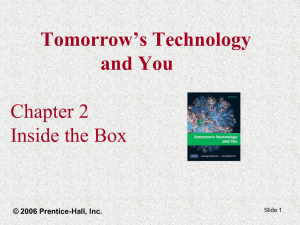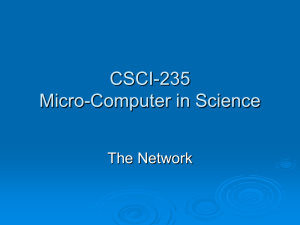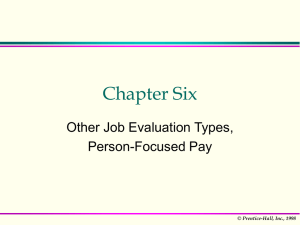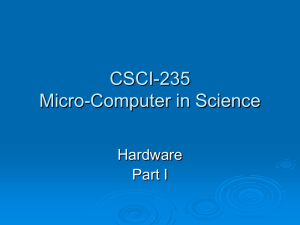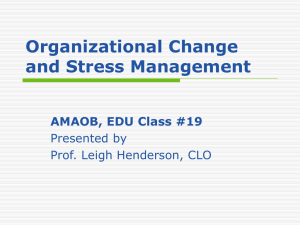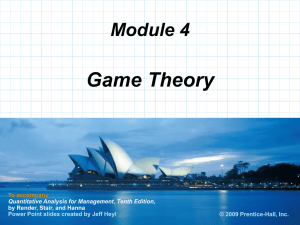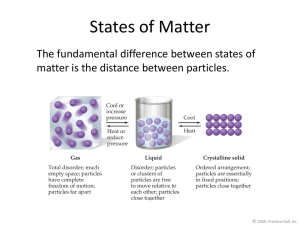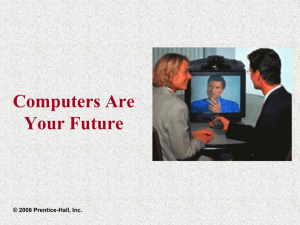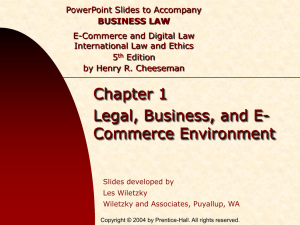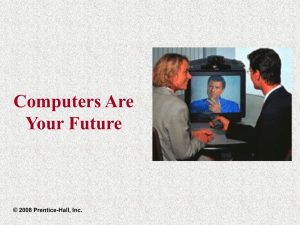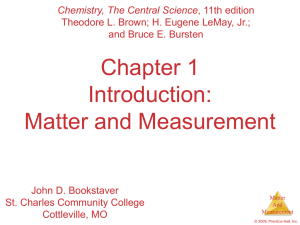Enterprise computing
advertisement
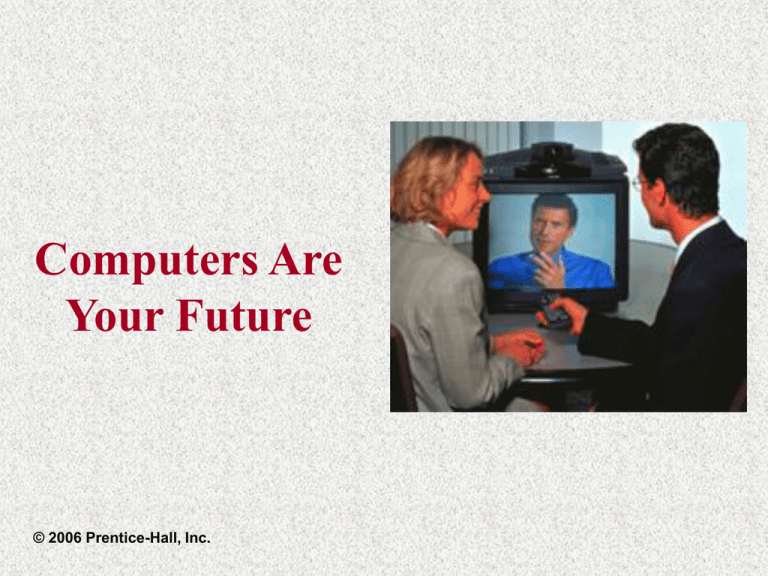
Computers Are Your Future © 2006 Prentice-Hall, Inc. Computers Are Your Future Chapter 14 Computers Are Your Future Chapter 14 Enterprise Computing © 2006 Prentice-Hall, Inc Slide 2 Computers Are Your Future Chapter 14 What You Will Learn About Enterprise computing Business processes and their flow within an organization Information systems that are managed in a centralized vs. distributed manner The tools that are commonly used in enterprise computing Enterprise storage systems Electronic data interchange Teleconferencing Telecommuting and workgroup commuting © 2006 Prentice-Hall, Inc Slide 3 Computers Are Your Future Chapter 14 Enterprise Computing An enterprise is a business organization Enterprise computing is the use of technology, information systems, and computers within a business © 2006 Prentice-Hall, Inc Slide 4 Computers Are Your Future Chapter 14 Business Processes and Activities Business processes are activities that have an identifiable output and add value to an organization’s customers Information systems are used to give a business a competitive advantage Employees Information Partners Suppliers Customer Enterprise © 2006 Prentice-Hall, Inc Slide 5 Computers Are Your Future Chapter 14 Enterprise Systems Enterprise systems are information systems that allow companies to integrate information across operations on an organization-wide basis Enterprise systems: Provide a common information storage area available to all corporate users Help companies find ways to increase goods and services, customer satisfaction, and profitability Are composed of hardware, software, people, and procedures © 2006 Prentice-Hall, Inc Slide 6 Computers Are Your Future Chapter 14 Enterprise Systems Globalization refers to conducting business internationally where the transaction of goods and services is transparent to the consumer © 2006 Prentice-Hall, Inc Slide 7 Computers Are Your Future Chapter 14 Centralized vs. Distributed Structures Centralized structures are managed by a central IT department Each network entity contains the same software and configuration settings © 2006 Prentice-Hall, Inc Slide 8 Computers Are Your Future Chapter 14 Centralized vs. Distributed Structures Distributed structures enable each user to customize their technology tools Each network entity contains its own software and configuration settings © 2006 Prentice-Hall, Inc Slide 9 Computers Are Your Future Chapter 14 Business Processing Reengineering (BPR) Business processing reengineering is the use of information technology to bring about major changes and cost savings in an organization © 2006 Prentice-Hall, Inc Slide 10 Computers Are Your Future Chapter 14 Applying Technology in the Enterprise Currency: All technology in an organization is more or less current Technology users have a certain comfort level in using the technology Tension exists between the current system and the most current technology available © 2006 Prentice-Hall, Inc Slide 11 Computers Are Your Future Chapter 14 Applying Technology in the Enterprise Upgrading: Things to consider when upgrading technology: Impact on the user Will hardware need to be upgraded? Cost of the upgrade Centralized structures are easier and less costly to upgrade than distributed structures © 2006 Prentice-Hall, Inc Slide 12 Computers Are Your Future Chapter 14 Applying Technology in the Enterprise Maintenance: Centralized structures are easier and less costly to maintain than distributed structures Users must be trained to use the new technology Scalability: How well a hardware or software system can adapt to increased demands © 2006 Prentice-Hall, Inc Slide 13 Computers Are Your Future Chapter 14 Applying Technology in the Enterprise Interoperability: The ability of software and hardware from different vendors to share data All computers on a network can interact seamlessly Disaster Recovery A disaster recover plan is a written plan with detailed instructions if something goes wrong © 2006 Prentice-Hall, Inc Slide 14 Computers Are Your Future Chapter 14 Applying Technology in the Enterprise Adding Workstations and Applications: Problems can occur as new workstations and applications are added Single point of failure (SPOF) is when a failure will cause a malfunction in an entire system © 2006 Prentice-Hall, Inc Slide 15 Computers Are Your Future Chapter 14 Applying Technology in the Enterprise Adding a Network: Zero configuration (Zeroconf) is a method used to network devices without requiring configuration © 2006 Prentice-Hall, Inc Slide 16 Computers Are Your Future Chapter 14 Tools for Enterprise Computing Enterprise Resource Planning (ERP): Software that integrates all facets of a business Replaces standalone computer systems with a single unified software program Drawbacks of ERP systems: One department impacts every department in the organization Resistance to change Cost and time in implementing the system may be prohibitive © 2006 Prentice-Hall, Inc Slide 17 Computers Are Your Future Chapter 14 Tools for Enterprise Computing Customer Relationship Management (CRM): Software application that includes all interaction between a company and its customers Computerization has changed the way organizations manage their customers; more of the relationship is being managed electronically Sales Force Automation (SFA): Technique of using software to automate sales tasks © 2006 Prentice-Hall, Inc Slide 18 Computers Are Your Future Chapter 14 Tools for Enterprise Computing Extensible Business Reporting Language (XBRL): An XML-based specification for publishing the financial information of an enterprise XML data tags are based on standardized accounting definitions Application Service Providers (ASP): Third-party entities that manage and distribute softwarebased services Enterprises can outsource their information technology needs © 2006 Prentice-Hall, Inc Slide 19 Computers Are Your Future Chapter 14 Tools for Enterprise Computing Operational Support System (OSS): A suite of programs that enable an enterprise to monitor, analyze, and manage a network system Enterprise Application Integration (EAI): A combination of processes, software, standards, and hardware that integrates two or more enterprise systems Enables sharing of data Four categories of EAI: Database linking Applications linking Data warehousing Common virtual system © 2006 Prentice-Hall, Inc Slide 20 Computers Are Your Future Chapter 14 Enterprise Storage Systems Redundant Array of Independent Disks (RAID): Two or more disk drives used in combination for fault tolerance and performance All information is recorded on both disk drives © 2006 Prentice-Hall, Inc Slide 21 Computers Are Your Future Chapter 14 Enterprise Storage Systems CD/DVD Jukeboxes: Enable storing, managing, accessing, and sharing DVDROMs and CDs Network-Attached Storage (NAS): Server dedicated to file sharing Provides data to the user © 2006 Prentice-Hall, Inc Slide 22 Computers Are Your Future Chapter 14 Enterprise Storage Systems Storage Area Network (SAN): High-speed subnetwork of shared storage devices All storage devices are made available to all servers Network-Attached Storage (NAS) High performance devices for data and file sharing Only supplies data to users © 2006 Prentice-Hall, Inc Slide 23 Computers Are Your Future Chapter 14 Enterprisewide Technologies Web Portals: Web sites that offer an array of resources and services AOL was one of the first portals The centralized management areas help create consistent business processes Electronic Data Interchange (EDI): Involves the transfer of data between different companies using networks Used as a mechanism for companies to buy, sell, and trade information © 2006 Prentice-Hall, Inc Slide 24 Computers Are Your Future Chapter 14 Enterprisewide Technologies Intranet: A network based on TCP/IP protocols accessible only by an organization’s members Used to share information Web-based training (WBT) provides training and/or instruction for employees by way of the Internet or an intranet Computer-based training (CBT) is a type of education in which the student learns by taking special training programs on a computer © 2006 Prentice-Hall, Inc Slide 25 Computers Are Your Future Chapter 14 Enterprisewide Technologies Extranet: Intranet that is accessible to authorized outsiders Allows business partners to share information Virtual Private Network (VPN): Network constructed by using public wires to connect nodes Encryption and security measures ensure only authorized users can access the network © 2006 Prentice-Hall, Inc Slide 26 Computers Are Your Future Chapter 14 Enterprisewide Technologies Computer-based training (CBT) form of computerbased education that uses multimedia, animation, and programmed learning Web-based training (WBT) is CBT using the Internet or an intranet © 2006 Prentice-Hall, Inc Slide 27 Computers Are Your Future Chapter 14 Enterprisewide Technologies Teleconferencing – two or more people use telecommunication and computers to conduct business activities © 2006 Prentice-Hall, Inc Slide 28 Computers Are Your Future Chapter 14 Enterprisewide Technologies Telecommuting – connecting to the office using telecommunications and computers from home © 2006 Prentice-Hall, Inc Slide 29 Computers Are Your Future Chapter 14 Enterprisewide Technologies Workgroup computing – members of a workgroup have specific hardware and software that enables them to connect, communicate, and collaborate Software that provides support for the information needs of work groups is called groupware © 2006 Prentice-Hall, Inc Slide 30 Computers Are Your Future Chapter 14 Chapter 14 Summary • Enterprise computing is the use of technology, information systems, and computers within an organization or business • Business processes are activities that have an identifiable output and add value to an organization’s customers • In a centralized structure, the management of technology is centered in the IT department © 2006 Prentice-Hall, Inc Slide 31 Computers Are Your Future Chapter 14 Chapter 14 Summary (continued) • Tools commonly used in enterprise computing include: Enterprise resource planning (ERP) Customer relationship management (CRM) Sales force automation (SFA) Extensible Business Reporting Language (XBRL) Application service providers (ASPs) Operational support systems (OSS) Enterprise application integration (EAI) • Redundant Array of Independent Disks (RAID) employs two or more drives in combination for fault tolerance and performance © 2006 Prentice-Hall, Inc Slide 32 Computers Are Your Future Chapter 14 Chapter 14 Summary (continued) • Electronic data exchange is a set of standards that specify how to transfer data and documents using networks • Teleconferencing is conducting business by more than two people separated by distance • An employee who works from home while connected to a business is telecommuting © 2006 Prentice-Hall, Inc Slide 33
